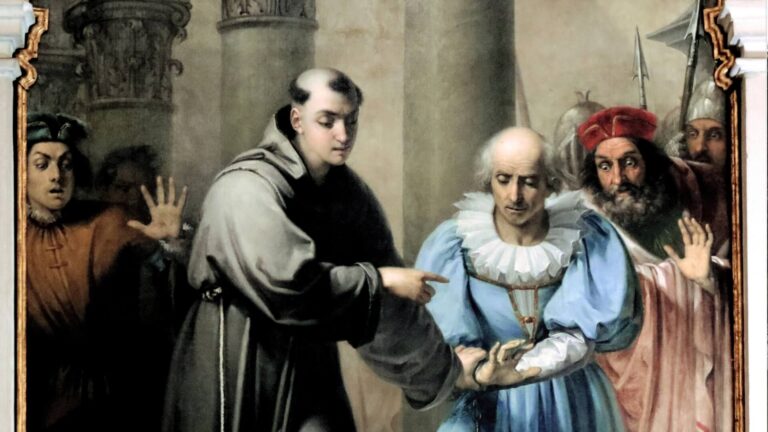ARTISTS’ ROADS
LE VIE DEGLI ARTISTI
watch the videos at the bottom of the page!
SAN VENDEMIANO
Miracle in Lisbon. The Painting of Giovanni Marchesi
Lisbon. Beneath a portico with Moorish arches, a miracle is taking place.
Saint Anthony of Padua has just brought a young man back to life. His father, the knight Martino Buglioni, had been accused of his murder. Wrongly. Only the unfortunate youth can clear his name and reveal the truth.
The figures act with eloquent gestures. The judge, incredulous, bulges his eyes. The true culprit, unmasked, seems on the verge of fleeing. Anthony, imposing, clothed in his own moral authority, questions the revived youth and points to his father. The latter is a figure of rare beauty, weighed down by iron shackles and false accusation. Below, the young man, still lying in the tomb, has just begun to speak. And in a moment, the armed guards massed in the background will know for certain whom they must arrest.
This remarkable painting arrived in San Vendemiano in 1834. The new parish church had been consecrated ten years earlier, and a striking image was needed to honour Saint Anthony of Padua at the side altar dedicated to him.
The artist was twenty-eight-year-old Giovanni Marchesi. The son of farmers from the Val di Non, he had long since moved to Venice, where he studied at the Accademia di Belle Arti. His genius had drawn strength from the painting of Paolo Veronese, Giambattista Tiepolo, and his contemporary, Francesco Hayez.
His brush is steeped in light, saturated with colour. His atmospheres are fluid, rich in tonal gradation and surprising contrasts.
With the eye of a refined portraitist, the painter from Trentino conjures figures that are vivid and tangible.
For the altarpiece in San Vendemiano, he received a formal commission and an advance of 918.15 lire. He responded with a letter, pledging the utmost diligence so that his work might have a “good effect” and “deserve compassion.”
He soon produced a preparatory study: pen, bistre, and watercolour on paper. A precious document that allows us today to trace the evolution leading to the final work.
In the painting, compared to the sketch, the Saint and his father are brought into greater prominence. The pale right hand of Anthony, pointing to the accused, becomes the pivot of the entire composition. The elderly father takes on new features. In the final work, his exquisitely ornate robe contrasts with his grey hair and downcast gaze, a tribute to Tiepolo, but also an echo of another altarpiece on the same subject, recently painted for Treviso Cathedral by Marchesi’s contemporary, Giuseppe Murani.
In the final painting, the resurrected youth occupies a more open and isolated space. For this figure, the painter had prepared a second study focusing on the face in profile and the posture. But in the end, he chose to depict him from behind.
The hagiographic source for the painting, perhaps suggested by the commissioners, was The Life of the Portuguese Thaumaturge Saint Anthony of Padua by Manuel de Azevedo, printed in Venice in 1818, in its fourth edition. Here is how the author describes the miracle: “Having arrived where the dead youth lay, Anthony commands that the decaying corpse be uncovered, and boldly, in a loud voice, he calls to it, and in God’s name urges it to declare to the judges present whether Martino de’ Buglioni was his killer. At the conjuration, the corpse sits up in a half-reclining pose, one hand on the ground and the other raised upwards, and like a living man responds with a clear voice, understood by all, that Martino de’ Buglioni was not his killer.”
Giovanni Marchesi died shortly after, in 1835, his life cut short by the same misfortune that claimed many young Trentino artists in the early nineteenth century. He is buried in the cemetery of San Michele in Venice.
The San Vendemiano altarpiece is an eloquent testimony to his talent, the unfulfilled promise of a brilliant future.
MORE EXPERIENCES!
I pittori “foresti”:
- Stephan Zavrel a Sarmede
- Giocondo Protti a Refrontolo
- I pittori itineranti a Godega
- Il Pozzoserrato a Conegliano
MULTIMEDIAL MAP: “ARTISTS’ ROADS – LE VIE DEGLI ARTISTI- EN”!

